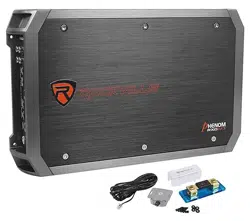Loading ...
Loading ...
Loading ...

6
ADJUSTING THE SYSTEM
Once the system is operational, the rst thing to do, is set all crossover points to approximate
settings. In the case of the basic sub woofer system Low Pass lter crossover at 100 Hz or so.
Set the Bass Boost equalizer controls to 0 dB ( Flat Switch Position.)
Now you should set the ampliers Input Sensitivity adjustment. The knob accessible on the side
of the amplier marked INPUT LEVEL adjusts the input sensitivity from 150mV to 8 Volts.
To adjust the input sensitivity, turn the control using a small at head screwdriver fully counter
clock wise to the minimum position. Do not apply any pressure while turning as this might break
the control unit. Adjust your radio volume level to maximum volume. Now turn the level control
on the amplier clockwise towards the Maximum marking until audible distortion occurs. When
you begin to hear any distortion in the sound, back down one notch and your amp is set. It is
helpful to have a second person to help you set the gain.
When setting up a multi-amp system, set each amplier’s gain separately. Start o with the bass
amplier, then adjust the highs amplier’s level control to match.
Once you are satised with the level control settings, use any equalizer controls to adjust the
system tonal level for personal preference. Keep in mind that after equalizing, you may have to
go back and reset the ampliers level controls.
*** The level control of any car amplier should not be mistaken for a volume control. It is a
sophisticated device designed to match the output level of your source unit to the input level
of the amplier. Do not adjust the amplier gain to maximum unless your input level requires it.
If your unit has been professionally installed please do not change the gain settings set by the
installer, he is the professional!
Your system can also be extremely sensitive to noise when the LEVEL is set to maximum and
does not match your input signal. The gain adjustments need to be made only once when rst
setting up the system.
USING THE ELECTRONIC CROSSOVER - 4 CHANNEL MODELS
The four and ve channel models feature separate crossovers for channels 1-2, 3-4,
and 5. All the RX Phenom Series ampliers feature 12dB per octave fully adjustable
low-pass and high pass electronic crossovers.
FOUR CHANNEL AMPLIFIER CONFIGURATIONS.
1. All four channels High Pass for internal component speakers in doors and rear
decks.
2. Channels 1 and 2 High Pass for front component speakers, while channels 3 and
4 are wired to sub woofers.
3. Bridge channels 1 and 2 for single high power sub woofer channel. Bridge channels
3 and 4 for second high power sub woofer channel.
For Low Pass systems, set the CROSSOVER MODE switch to LOW PASS. Now
the knob marked FREQUENCY will control the low pass frequencies from 40Hz to
150Hz. A frequent mistake made is setting the low pass frequency too low, especially
when using vented sub woofer enclosures. We recommend that for most installations
you do not set the frequency knob lower than 100Hz (the 12 o’clock position).
When using the ampliers for component speakers or coaxial, you will want to set the
CROSSOVER MODE switch to HIGH PASS. The FREQUENCY control knob adjusts
the high pass frequencies between 50Hz and 500Hz. Do not attach tweeters directly
to the amplier even in the high pass mode without a secondary passive crossover to
protect them. 500Hz high pass is not a frequency high enough for tweeters.
PASSIVE SUBSONIC FILTERING
For sub woofer installations with a passive LP crossover, you can set the amplier’s
CROSSOVER MODE selector to HIGH PASS while setting the FREQUENCY KNOB
to 40Hz, this will act as SUBSONIC FILTER for all signals below 40Hz. This is
especially useful for vented enclosures where the port tuning frequency falls below
the sub woofer tuning frequency to protect against sub woofer unloading.
Installation Basics
Loading ...
Loading ...
Loading ...
